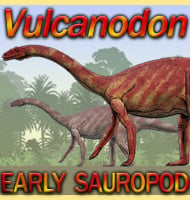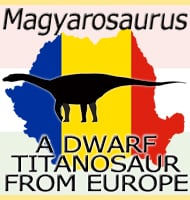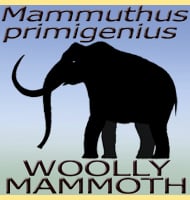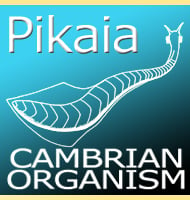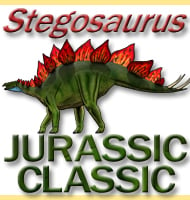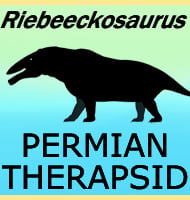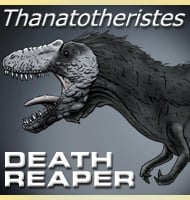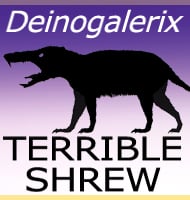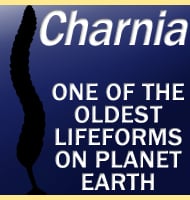Hadrosaurs, called “duck-billed dinosaurs,” were some of the coolest animals to ever live (at least for me!).
They had funny-shaped snouts, some had crests on their heads, and they lived in big herds. These plant-eating giants ruled during the Late Cretaceous period, living side by side with some of the most famous predators in history, like Tyrannosaurus rex.
But don’t be fooled by their seemingly humble diet of ferns and conifers—hadrosaurs were far more complex and intriguing than they first appear.
Imagine this: an animal that could make sounds using special chambers in its skull. These sounds might have been as deep and loud as a foghorn or as pretty and detailed as birdsong.
Some hadrosaurs grew larger than Asian elephants, Others had crests that were fancier than almost any other dinosaur’s horns.
They were social animals, moving in herds that might have been as big and impressive as today’s wildebeest migrations.
What truly sets hadrosaurs apart, however, is how well they’ve been preserved in the fossil record.
From fossilized skin impressions to entire bone beds, hadrosaurs offer us some of the most detailed glimpses into the lives of dinosaurs.
Because of this, hadrosaurs are super important for scientists in understanding prehistoric ecosystems and the evolution of herbivorous dinosaurs.
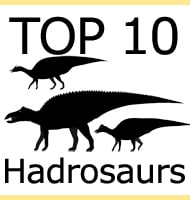
In this list, we’ll look at the Top 10 Hadrosaurs and learn about their coolest features. From the giant Shantungosaurus to the strange, crested Lambeosaurus, each hadrosaur has its own amazing story to tell.
10 - Magnapaulia
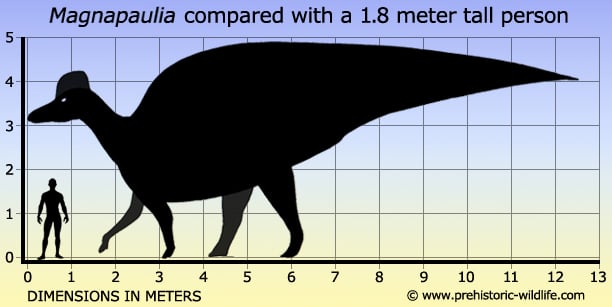
The hadrosaur dinosaurs are all noted for having high neural spines on their vertebrae, but those of Magnapaulia are particularly high.
This has led to fresh speculation that Magnapaulia may have used these spines to increase body area to help with swimming, like a huge paddle.
However in the past this idea has been speculated for other hadrosaurs too, including those that lived on large plains.
In actuality whether hadrosaurs swam frequently and for extended periods may have been more down to population locations and local features rather than a predisposition to the activity.
The spines might equally have been to increase a display area, or to help prevent large predatory dinosaurs like tyrannosaurs inflicting a bite to the spinal cord.
9 - Gryposaurus
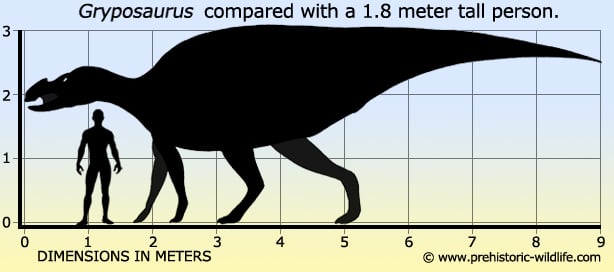
There is no known evidence that suggests a skull crest in Gryposaurus, but then the crest might not have been here given the greatly enlarged nasal structure.
This was almost certainly the support for a large nasal display, though exactly what shape is uncertain.
Softer tissues may have wrapped around the bone to create a similarly shaped display, or the bone may have simply been the anchor point for an even larger display feature.
8 - Saurolophus
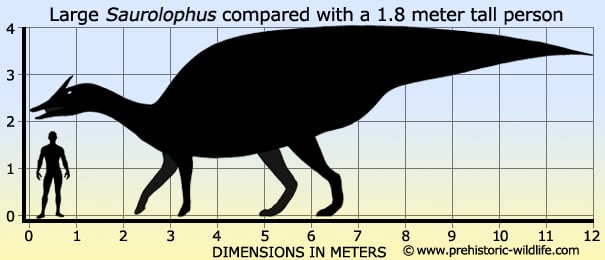
Saurolophus is the type genus of the saurolophinae, a group of hadrosaurids that are noted for having no to very small solid bony crests.
Saurolophus is also one of the few hadrosaur genera known from both Asia and North America, indicating that as a genus Saurolophus was particularly successful.
Key to this success may have been adaptability given that Saurolophus fossils are known from both inland and coastal areas.
7 - Secernosaurus
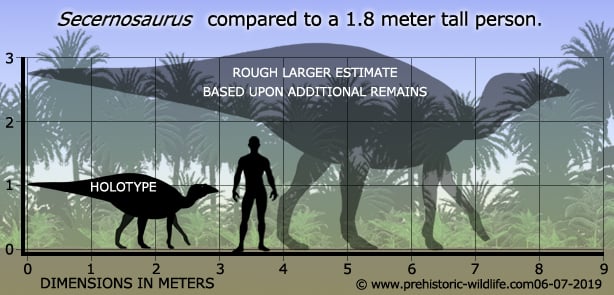
Hadrosaurids have been found to be very common in both North America and Asia, but are not very well known from elsewhere.
So imagine how surprised palaeontologists were when a hadrosaurid was discovered in South America, a continent that was supposed to have been isolated from North America and the rest of the world at the time that hadrosaurids were walking it.
This could mean one of two things.
One is that the ancestors of the ancestors of the hadrosaurids the hadrosauroids that had evolved from the ornithopods of the Jurassic made it to South America when it was still connected to Africa, and continued to evolve along the same lines as hadrosaurs in other parts of the world.
This would have been around the early cretaceous as explained by the presence of spinosaurid theropods in both Northern Africa and South America at this time.
Carcharodontosaurs are also known from both continents.
The second theory is that for a relatively short time North and South America were reconnected for a short period of time, but long enough for a faunal interchange between the two.
Either way, Secernosaurus is no longer the only genus of hadrosaur known from South America with Willinakaqe being another.
6 - Shantungosaurus
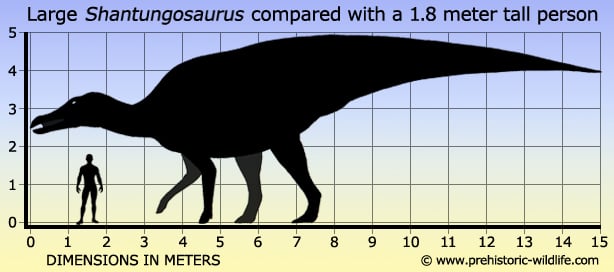
Shantungosaurus may just be the largest hadrosaurs that ever walked the Earth.
This colossal size also makes Shantungosaurus to potentially be the largest ornithischian (bird hipped) dinosaur to walk the Earth (note, the huge sauropods and titanosaurs were saurischians).
There are not currently any known head display features, though the nasal openings of the skull are notably large.
This may indicate the presence of a soft tissue display feature, or perhaps the nasal opening were larger simply to provide the much larger body with proportionately more oxygen.
5 - Lambeosaurus
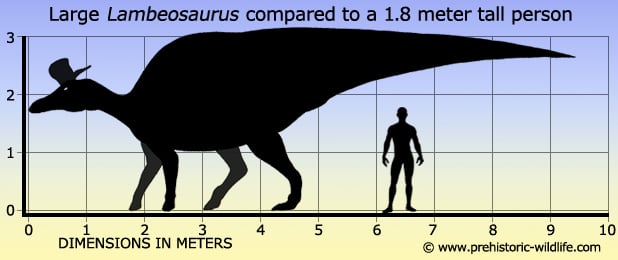
Lambeosaurus is the type genus of the lambeosaurinae, the group of hadrosaurids that are noted for having hollow bony crests, some of them quite elaborate.
The crest of Lambeosaurus is most commonly described as hatchet shaped, with the ‘blade’ pointing up and forwards, and the ‘handle’ pointing backwards.
Because the crest is hollow, it has been speculated to be a form of resonating chamber that amplified the sounds of calls, though it may have been hollow just to save on the weight sitting on top of the skull.
The long taxonomic history of Lambeosaurus is important learning for those studying hadrosaurs, given that study of Lambeosaurus goes back to the early twentieth century, and at times criss-crosses with other genera and species.
4 - Maiasaura
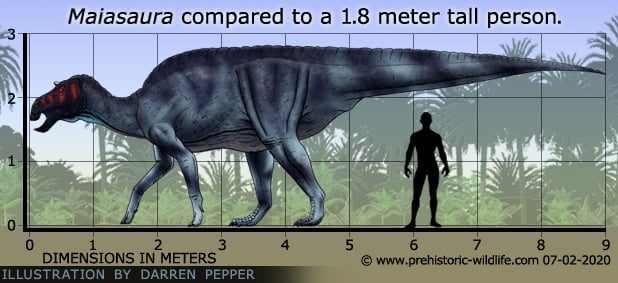
Maiasaura means ‘good mother lizard’, and this is a reference to the area that has been dubbed ‘egg mountain’.
This area seems to have been a huge nesting area for Maiasaura, and was amongst the first clear indications that hadrosaurs, and quite possibly dinosaurs in general, actually took the time and effort to raise their young, and not abandon them to the wilds, a popular misconception prevalent in early depictions of dinosaurs.
3 - Hypacrosaurus
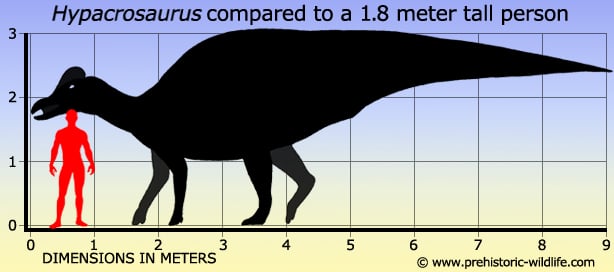
Hypacrosaurus was named over fifty years before Maiasaura, but it was new discoveries for the genus that took place after the naming of Maiasaura that saw large numbers of eggs and juveniles added to the genus.
This has helped palaeontologists to get a clearer indication of how juveniles grew and developed, including the physical changes in body proportions.
Hypacosaurus was similar to the more famous Corythosaurus, and the name means ‘near the highest lizard’.
This was actually a reference to the genus Tyrannosaurus which has popularly been dubbed the highest dinosaur in terms of popularity.
2 - Parasaurolophus
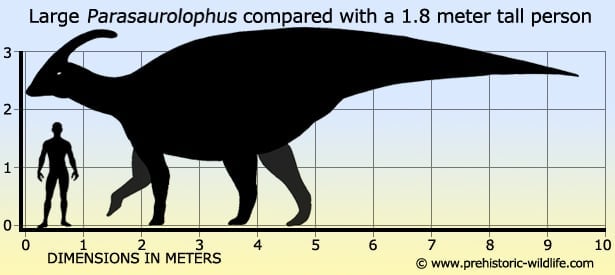
Parasaurolophus is amongst the most popular hadrosaurid dinosaurs, and it’s all thanks to the unusual head crest that rises up from the top of the skull.
This crest is hollow and over the years a great many theories have been devised as to the function of the crest (discussed in detail on the main Parasaurolophus page).
For a long time Parasaurolophus was considered unique, but at least one another genus of hadrosaur named Charonosaurus had a similar head crest to Parasaurolophus.
1 - Edmontosaurus
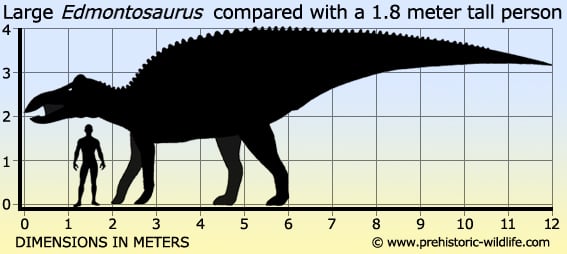
Anyone interested in the science and study of hadrosaurid dinosaurs needs to look at one genus more than any other: Edmontosaurus.
Even with roughly a century of study, the genus is still surprising palaeontologists and challenging long established notions about hadrosaurids.
It was only as recently as 2013 that it was proven that Edmontosaurus had a small soft tissue crest on top of its head.
This proves that even though the saurolophine hadrosaurs lacked elaborate bony head crests like lambeosaurines, at least some still had head ornamentation.
Edmontosaurus has amongst the highest number of fossils attributed to a dinosaur genus, and aside from bones, impressions of skin, soft tissues even mummified remains are known for it.
There are even fossils that show that Edmontosaurus were actively preyed upon by large tyrannosaurs, perhaps even Tyrannosaurus.
Larger fossils also indicate that Edmontosaurus may have grown to around twelve to thirteen meters long, making it one of the largest hadrosaurs known to have lived in North America.
FAQ‘s
-
How old are Hadrosaurs?
Hadrosaurs lived during the Late Cretaceous period, about 75 to 65 million years ago. These plant-eating giants were alive just before an asteroid hit the Earth and caused the dinosaurs to go extinct.
-
Is a Hadrosaur a relative of ducks?
Not really, even though people call them “duck-billed dinosaurs” because their snouts look like a duck’s bill. Instead of swimming or dabbling in water like ducks, hadrosaurs used their flat beaks to pull off plants and chew them with their hundreds of teeth.
-
How large did Hadrosaurs grow?
Hadrosaurs could be very different in size. Some grew up to 50 feet (15 meters) long and weighed as much as 15 tons—about the weight of a school bus! Others were smaller and quicker, showing how diverse the group was.
-
What was the purpose of the crests on some Hadrosaurs?
The crests on hadrosaurs like Parasaurolophus and Corythosaurus were amazing and had many uses:
Communication: Their hollow crests could make loud sounds to talk to others far away.
Display: The crests might have helped attract mates or scare off rivals, like peacock feathers or antelope horns.
Species Identification: Different crest shapes helped hadrosaurs tell their own kind apart from other species. -
How did Hadrosaurs defend themselves from predators?
Hadrosaurs didn’t have sharp claws or armor like some other dinosaurs, but they had smart ways to stay safe, Their strong legs helped them run fast to escape predators like Tyrannosaurus rex.
They stayed in big groups, which helped protect them. A large herd could scare off predators.
They might have used loud sounds, made with their crests or voices, to warn their herd when danger was near.

